The campers explored the
world via maps
they found on the web.
They also visited Wikipedia and Google to learn how to use them for
research. Then they were set on a quest for some very
specific
facts on the web. If you have ever participated in a
scavenger
hunt to collect each item on a list of unrelated things you have some
idea of what they were trying to do in the realm of
information.
Physics
This year we
concentrated on how some
optical devices work and how we perceive the world around us visually.
These
pictures are anaglyphs of the classes. Anaglyphs are made
from
two pictures of the same subject taken from slightly different
angles. The pictures were tinted with red and blue filters
and
superimposed. If you look at them with a blue filter over
your
right eye and a red filter over your left eye you will see the classes
in three dimensions. The filters allow each eye to see a
separate
image which the brain merges into a single 3D image. You can make your
own viewer using a piece of clear plastic like that used in packaging
toys and electronic items. Cut a piece about 1 by 3 inches
then
use markers to color one end red and the other blue. We found
the
permanent markers work a lot better than the erasable kind.
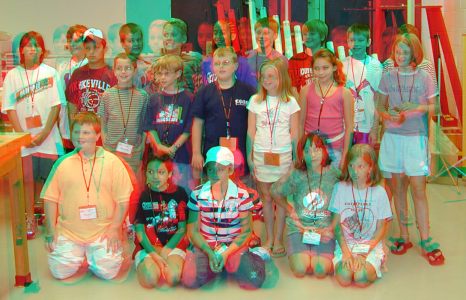
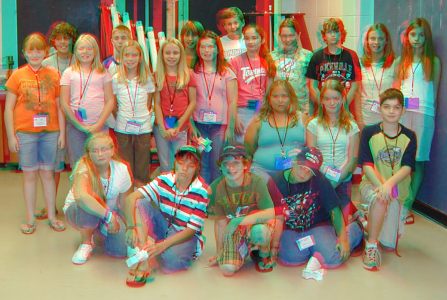
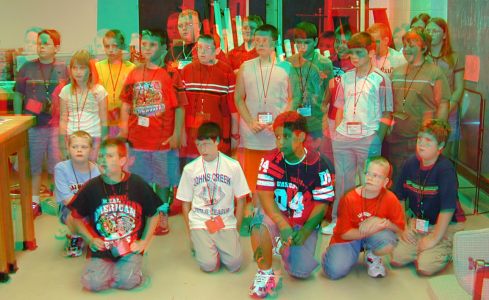
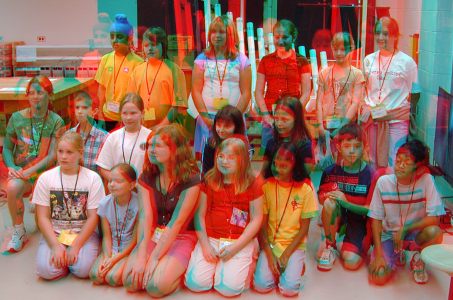
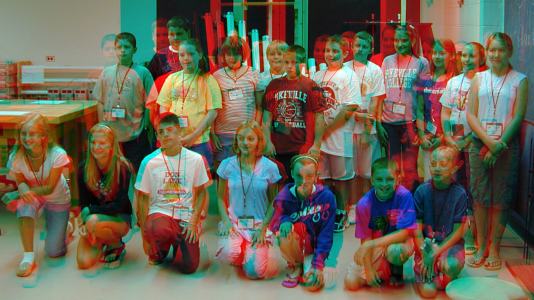
Here they are looking at
some anaglyph
pictures. The boy on the left is checking the effect of
reversing
the red and blue filters. One of the kids said when you did
that
it looked like the
pictures were inside out. Try it yourself to see what he was
talking about.
Here they are checking
technologies that
were popular many years ago that also produced 3D images, the
stereoptican and ViewMaster viewers.
As well as making the
viewers we
investigated the
properties of positive, negative, fresnel, cylindrical and flexible gel
lenses.
They looked at themselves
in positive
and negatively curved
mirrors and one that had a variable focal length. They dissected
cameras,
checked the properties of eye glasses that corrected near and far
sightedness and astigmatism.
We took a look at
polarized light
and
how it is used in liquid crystal displays like those in cell phones and
computers and that it can be used to show the stresses in some plastics
and glass.
And they all got to see
themselves in a
human kaleidoscope.
The students also built
pinhole cameras
and used them to take pictures. The subject was a still life
"studio shot" of a small plastic mastodon, dinosaur or matchbox car, a
playing card, a domino and other similar size items. I think
you
can see that they were pleased with the results.
Earth
and Space
A sundial seems like it could be a fairly simple device but if you want
to build one that can work anywhere on earth it gets more
complicated. Carefully cut, fold, paste then set it for your
latitude, align it properly, and if the sun is out it will give you the
time.
Another challenge was to
build a
structure out of paper, straws, and paper clips that can stand up to an
earthquake. The earthquake was supplied by the shake table
you
see in the third picture at the moment of truth for one of the
structures.
Chemistry
Here are some of the campers using indicator solutions to test the
efficacy of antacids. They also compounded their own and
tested
those.
Biology
In biology this year they made models that showed how the lungs
work. A plastic bottle, some tubing, a little clay,
and
some balloons and you have a working model that shows how when a
person's diaphragm moves down air goes into their lungs.
The biology dissection
subject this year
was a mud puppy. It is a large salamander. The
classes
divided up into teams that used careful surgical techniques to see
their organs, nerves, blood system and muscles.
Contests
Each year the campers take part in a science
olympics.
Teams this year tool part in contests that included a water balloon
slingshot, chemical symbol word spell, marshmallow tower,
write
it build it, foil boat, laser target shoot, toothpick bridge and Who
Wants to be a Millionaire (science edition).
The big contest this year
required the
campers to build a car powered by rubber bands or a
mousetrap. It
was to travel down a course with success judged by how well it stayed
on course and how close it came to the center of the finish
line.
Here are some of the contestants with their very inventive entries.
And the winners are.....
Congratulations to all
those who
participated.
Volunteers
There is a previously unsung group that are essential to the camp ---
the volunteers. The instructors rely on them to help set up
the
classroom between classes and guide the campers when they need
assistance. No question about it, we appreciate
their help.
E-mail Nancy and Alan